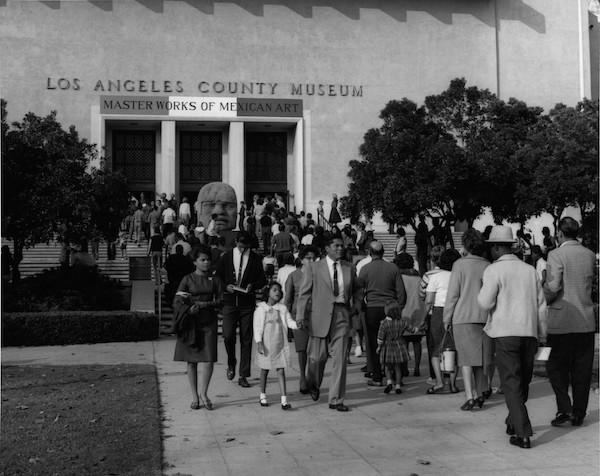Currently on view at LACMA is Found in Translation: Design in Mexico and California, 1915–1985, an exploration of collaborations and cross-pollinations in Mexican and Californian design. Exhibition curators Wendy Kaplan and Staci Steinberger of the Decorative Arts and Design department invited me to write a catalogue essay on the collecting and display of ancient Mexican art, since these objects were one source of inspiration in the creation of new works in both California and Mexico. While doing research for the essay (co-authored with Mary Ellen Miller), I worked with archivist Jessica Gambling to search for documentation related to Master Works of Mexican Art, from Pre-Columbian Times to the Present, an exhibition organized by the Mexican government that LACMA hosted in 1963–64. The exhibition opened to the public on October 2, 1963, and former Mexican president Miguel Alemán Valdés attended the opening festivities.

In addition to photographs, Jessica discovered audio and video reels. Only one document was found, but it was an especially interesting one—a requisition request for “6 wigs to fit existing figures” (mannequins). The requisition, dated 1/29/64—in the middle of the exhibition run—was marked “EMERGENCY” with an explanation: “(created by the unforeseen requirement to exhibit Mexican national costumes for the occasion of the prospective visit of the Presidents of the USA and Mexico).” The fact that both presidents planned to visit the exhibition indicates it was seen as noteworthy for U.S.-Mexico diplomacy.
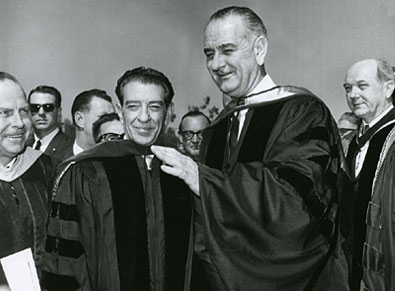
The catalogue’s title page acknowledges sponsorship by Adolfo López Mateos and John F. Kennedy, presidents of Mexico and the U.S. when the show opened. Since Kennedy was tragically assassinated the next month, Lyndon B. Johnson would have been the expected presidential visitor in 1964. Presidents López Mateos and Johnson visited Los Angeles on February 21, 1964, when they were keynote speakers at UCLA Charter Day and also received honorary doctorates. The presidents’ wives did visit LACMA to see the Master Works exhibition, but the presidents did not attend.
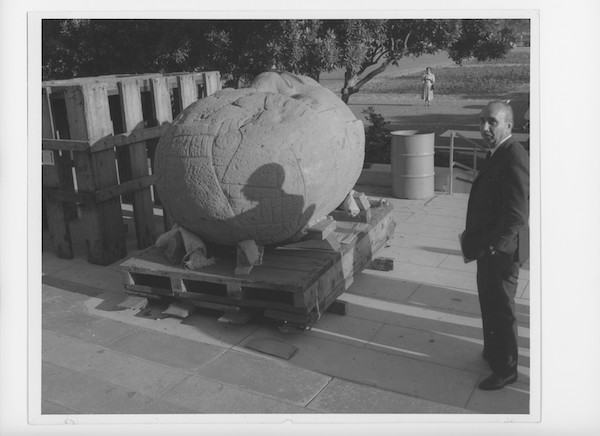
Master Works had traveled for several years in Europe’s capital cities (1959–63). Richard Brown, who had become LACMA’s first director, saw the show in Paris and subsequently advocated for it to come to Los Angeles, where it was the only U.S. venue. This was LACMA in its infancy, having just separated from the Museum of History, Science, and Art established in Exposition Park in 1913. The Art Department had organized many shows over the museum’s first 50 years, but art lovers and civic boosters wanted something more—an institution dedicated solely to art. In 1961, the Art Department formed a separate institution, relocating in 1965 to Wilshire Boulevard, where it remains today. Master Works was on display before the move, the Neoclassical Exposition Park building given a slight Mexican veneer with the exhibition sign colored red, white, and green like the Mexican flag.
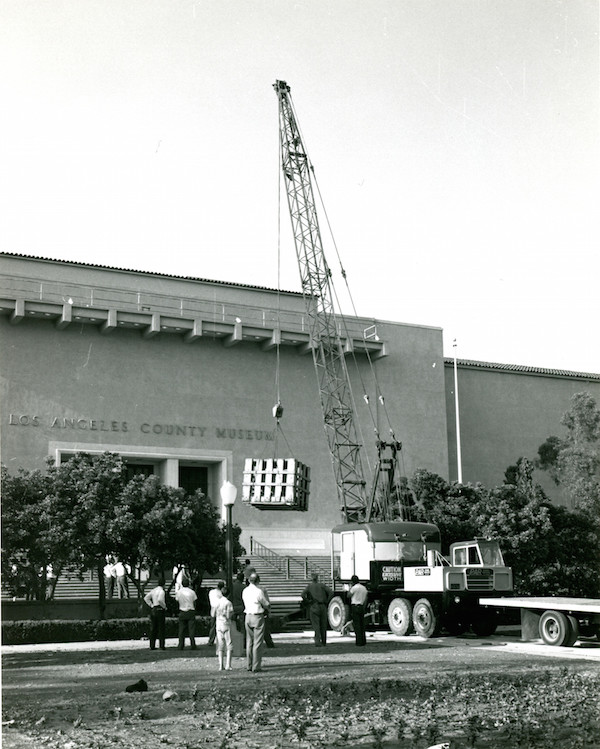
Organized by Fernando Gamboa, renowned museographer and once head of the Mexican National Institute of Fine Arts (INBA), Master Works drew upon Mexico’s deep national collections to present more than 3,000 years of Mexican art. The artworks, whose makers ranged from the ancient Olmec and Maya to modern painters like Diego Rivera and David Alfaro Siqueiros, as well as Spanish Colonial and folk artists, were destined for several new national Mexican museums that would be inaugurated in 1964. They included monumental ancient sculptures that had to be sent in a large ship—which traveled from Copenhagen through the Panama Canal—and handled with cranes, as seen in archival photographs showing works being unloaded from the ship or installed in front of the Exposition Park building. There also were large paintings such as Flower Day, a Rivera work already in LACMA’s collection, and hundreds of small objects, including at least 10 ceramic dog sculptures from West Mexico, as well as folk art made of clay and paper. Loans from private collections supplemented these treasures from the Mexican national collections.
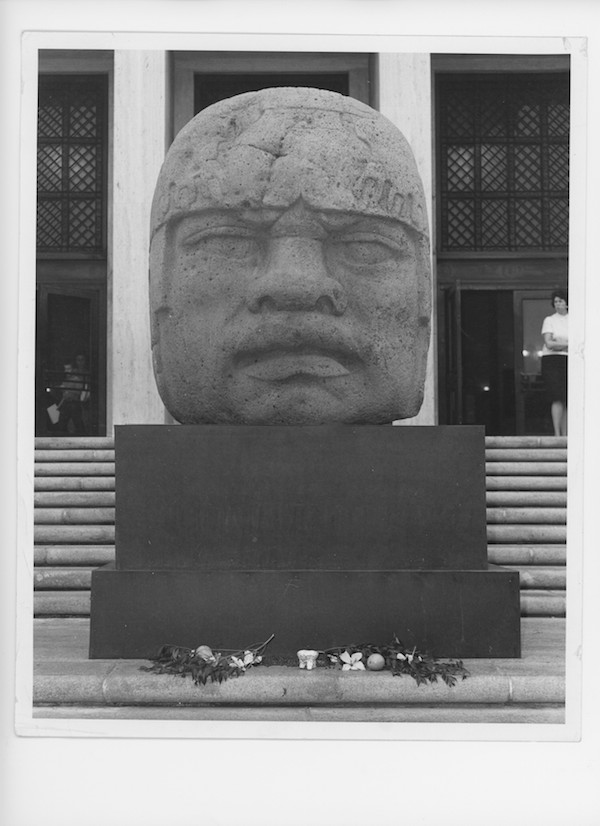
Visitors to the show were greeted by a monumental Olmec sculpture, the six-ton Colossal Head 5 from San Lorenzo, Veracruz. Installed on the south steps, it faced the Los Angeles Coliseum, providing a fitting view for that monumental sculpture of an ancient ruler who might have been a ballplayer too (although curators would not have known that then). It was a popular attraction, and one photo shows it with offerings of flowers and fruit.
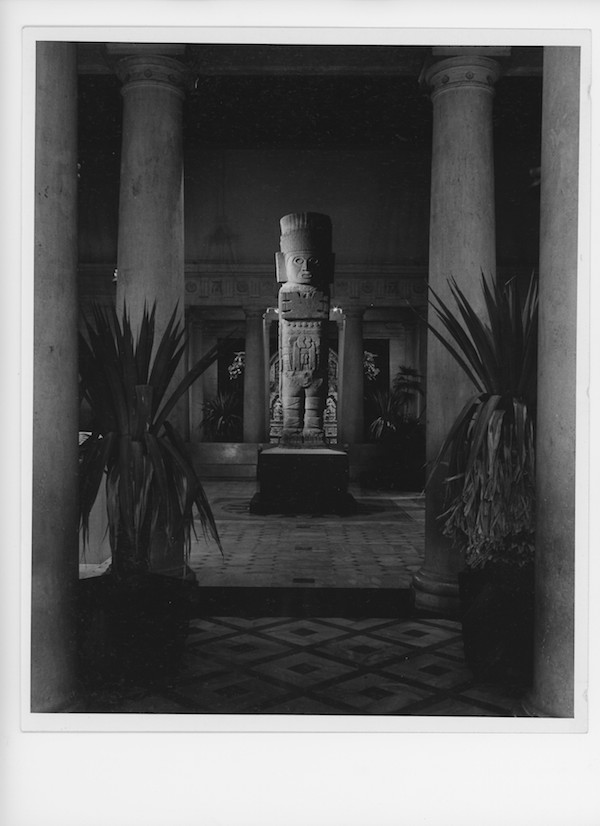
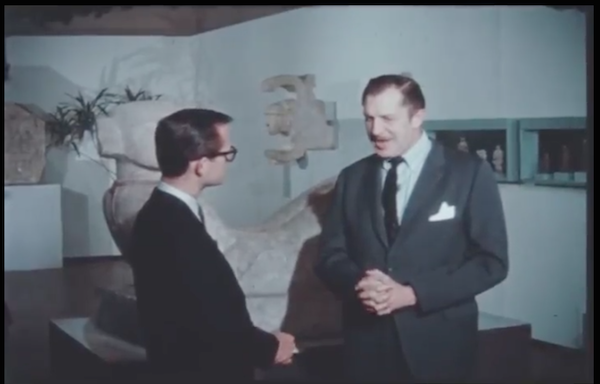
Excerpt from Impressions: Masterworks of Mexican Art, Paul Fuentes for KHJ-TV, a RKO General Production, narrated by Vincent Price, hosted by Wayne Thomas, 16mm files projected as digital file, 4:01 min., 1963, courtesy KCAL-TV, Los Angeles
Once inside, visitors received a delightful treat. While experiencing the glories of Mexican art, they could listen to famed actor Vincent Price narrating the show in an Acoustiguide that describes many objects in detail, with great emotion and affection (“Acoustiguide Tour of Masterworks of Mexican Art,” collection of the Balch Art Research Library, Los Angeles County Museum of Art, RT-0024-5). For a video produced by the KHJ-TV Public Affairs Department entitled “Impressions: Masterworks of Mexican Art,” the tour’s audio was paired with video footage of the exhibition and supplemented by dramatic music more fitting of a Price film. This video allowed TV viewers—and us today—to see close up the exhibition design, which included dramatic vistas and low lighting. (Video narrated by Vincent Price, hosted by Wayned Thomas, directed by Paul Fuentes, filmed by RSVP Rick Spalla Video Productions, produced by the Public Affairs Department of KHJ-TV, a RKO General Production, courtesy KCBS/KCAL).

At the beginning of this video, KHJ-TV host Wayne Thomas interviews Price about his art collecting and studies of Mexican art. When Thomas asked Price about the importance of Mexican art, Price responded: “I think that all Mexican art is of enormous importance. I think that the Pre-Columbian art is of special importance to us in this country to prove once again that we have a great indigenous art in this country and a great art heritage.” Price was a collector and enthusiast of ancient Southwestern U.S. art as well as ancient Mexican art, but in the context of the question relating to Mexican art, his answer makes it clear that he was eliding ancient indigenous U.S. and Mexican art and considering both traditions as U.S. heritage as well. Price and his wife Mary for years had purchased objects from the Stendahl Galleries of Los Angeles and other sources and displayed them in their home. But they also shared their collections: they lent to exhibitions organized by the Stendahl Galleries, and in 1957 they donated dozens of objects to East Los Angeles College, so that the students could see and appreciate them. Price’s narrated Acoustiguide and video may have attracted visitors to the LACMA exhibition.
257,000 people (including 20,000 schoolchildren) saw the Master Works exhibition in Los Angeles, adding to the millions who had seen it in Europe. Price called Master Works “the greatest single show of Mexican art that would ever be seen,” a suitable honorific, especially since the pieces were destined for multiple Mexican museums (Anthropology, Colonial, and Modern). Yet more were to come: in 1991, LACMA hosted Mexico: Splendors of Thirty Centuries, a blockbuster exhibition rivaling Master Works, and other important collaborations with the Mexican government have been Lords of Creation: The Origins of Sacred Maya Kingship (2005), Olmec: Colossal Masterworks of Ancient Mexico (2010), Children of the Plumed Serpent: The Legacy of Quetzalcoatl in Ancient Mexico (2012), and Picasso and Rivera: Conversations Across Time (2016–17). This year and next are again banner years for collaborations between Los Angeles museums and the Mexican government. Found in Translation at LACMA and Golden Kingdoms at the Getty Museum, both part of PST: LA/LA, feature key Mexican artworks and address cross-cultural relations across space and time, one in the 20th century (California and Mexico) and the other in antiquity (Mexico, Central, and South America).
.jpg)
In March 2018, LACMA will be privileged to open yet another blockbuster, this one focusing solely on a single ancient Mexican city. City and Cosmos: The Arts of Teotihuacan will present more than 200 objects from the great ancient metropolis of Teotihuacan. Currently at the de Young Museum in San Francisco and curated by Matthew Robb, it involves substantial collaboration with Mexico’s Instituto Nacional de Antropología e Historia (INAH). I am fortunate to be the curator for the LACMA exhibition. It is guaranteed to wow audiences, showing the glories of ancient Mexico and the significant archaeological research in Mexico today, including many pieces from the Tlalocan tunnel offerings excavated by INAH archaeologist Sergio Gómez Chávez and his team. It is yet another crucial moment to honor Mexico’s ancient heritage and to continue building bridges with California’s closest neighbor.
A longer clip from the Master Works video will be shown as part of the free film program No Walls, Only Bridges, which explores themes of travel, migration, labor, indigenismo, modernism, activist arts, architectural appropriations, and psychedelic tourism back and forth across the US–Mexico border. Join us on Sunday, October 15, at 1 pm at LACMA!
Further Reading:
“Feb. 21, 1964: UCLA Welcomes Presidents.” UCLA History, blog of the UCLA Alumni Association. https://alumni.ucla.edu/ucla-history/ucla-history-14/
Gamboa, Fernando. Master Works of Mexican Art, from Pre-Columbian Times to the Present (Los Angeles County Museum of Art, Los Angeles, 1963).
“Minutes of the Board of Trustees of the Art Museum.” August 6, 1963; December 10, 1963; February 4, 1964; March 3, 1964. LACMA Archives.
O’Neil, Megan E. and Mary Ellen Miller. “An Artistic Discovery of America: Exhibiting and Collecting Mexican Pre-Hispanic Art in Los Angeles from 1940 to the 1960s.” In Found in Translation: Design in California and Mexico, 1915-1985, ed. Wendy Kaplan, pp.162-167 (Los Angeles: LACMA and Prestel, 2017).
O’Neil, Megan E. “Collecting Pre-Hispanic Art in Los Angeles.” In Found in Translation: Design in California and Mexico, 1915-1985, ed. Wendy Kaplan, pp.176-177 (Los Angeles: LACMA and Prestel, 2017).
Robb, Matthew H. “The Pre-Columbian as MacGuffin in Mid-Century Los Angeles.” In LA Collects LA, ed. Jesse Lerner and Rubén Ortiz-Torres (Los Angeles, Vincent Price Art Museum, 2017).
Robb, Matthew H., ed. Teotihuacan: City of Water, City of Fire (San Francisco, Fine Arts Museums of San Francisco in association with University of California Press, 2017).
Schumach, Murray. “Mexican Art Seen by Many on Coast: Exhibition Is Drawing More than Any Expected: Show Toured Europe,” New York Times (25 October 1963).
Stendahl, Alfred and George M. Goodwin, Alfred Stendahl: Oral History Transcript (Los Angeles: Oral History Program, University of California, Los Angeles, 1977).



